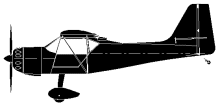
ASN Wikibase Occurrence # 138373
This information is added by users of ASN. Neither ASN nor the Flight Safety Foundation are responsible for the completeness or correctness of this information.
If you feel this information is incomplete or incorrect, you can submit corrected information.
| Date: | Sunday 4 September 2011 |
| Time: | 08:30 |
| Type: |  SkyStar Kitfox Series 7 |
| Owner/operator: | Private |
| Registration: | N624JS |
| MSN: | S70302022 |
| Year of manufacture: | 2008 |
| Total airframe hrs: | 162 hours |
| Engine model: | Rotax 912ULS |
| Fatalities: | Fatalities: 2 / Occupants: 2 |
| Aircraft damage: | Substantial |
| Category: | Accident |
| Location: | Caldwell Industrial Airport, Caldwell, ID -
 United States of America United States of America
|
| Phase: | Take off |
| Nature: | Private |
| Departure airport: | Caldwell, ID (EUL) |
| Lovelock, NV (LOL) | |
| Investigating agency: | NTSB |
| Confidence Rating: |
The builder/owner/pilot of the kit-built experimental airplane and his non-pilot-rated passenger flew from California to Idaho in order to attend the kit manufacturer’s fly-in and visit relatives. Two days before the accident, they flew to Idaho, and the next day they flew 4 hours. On the third day, the airplane was taxied from its parking spot on the ramp about 0740, and the pilot conducted a takeoff to about 50 feet, before landing straight ahead on the remaining runway. The investigation was unable to determine the purpose of this flight, or whether the passenger was on board at that time. The airplane was then taxied back to the ramp. About 13 minutes later, the airplane left the ramp again, taxied to the opposite runway, and began another takeoff roll. When the airplane was about 200 feet above the runway, the engine stopped developing power. The airplane stalled and spun to the ground, impacting on airport property near the departure end of the runway.
Weight and balance calculations indicated that the airplane was likely 60 to 100 pounds above its maximum allowable weight, and that the center of gravity was about 1.7 inches forward of the aft limit, which would have increased the airplane pitch up tendency following the loss of engine power. Because the airplane was experimental and the pitch trim setting was unable to be determined during postaccident examination, the investigation was unable to determine whether there was sufficient control authority to prevent the stall and also what the required control forces would have been.
Examination of the wreckage revealed that the two installed air filters had flow capacities well below the minimum value specified by the engine manufacturer, which would have limited the engine’s ability to develop its full rated power. However, this was not a factor in this accident, because the airplane had been flown successfully in the previous days.
The engine was not equipped with carburetor heat, even though it was required by the engine manufacturer. When plotted on a carburetor icing chart, the ambient air temperature and dew point values indicated that conditions for serious carburetor icing at cruise power existed. The engine-driven fuel pump was too damaged to test, but the engine manufacturer noted that it should have been replaced in accordance with a 2007 Service Bulletin, which warned that excessively high fuel pressure could result in “engine malfunction and/or massive fuel leakage.” Although the possibility exists that the engine experienced a total loss of power due to carburetor icing, excessive fuel pressure, or a combination of the two, the investigation was unable to conclusively determine whether either caused the loss of engine power.
Finally, no evidence of an angle-of-attack or stall warning system was observed in the wreckage. Although not required, such a system might have alerted the pilot of the impending stall and helped him avoid the stall and subsequent spin.
Probable Cause:
The pilot’s failure to prevent a low-altitude stall and spin following a complete loss of engine power during the initial climb after takeoff.
Accident investigation:
 |
|
Sources:
NTSB
FAA register: http://www.idahopress.com/news/local/caldwell-airplane-crash-kills/article_51bcd148-b298-5506-8bc2-8149e7812d95.html
http://registry.faa.gov/aircraftinquiry/NNum_Results.aspx?NNumbertxt=N624JS
http://www.airnav.com/airport/KEUL
http://forums.matronics.com/viewtopic.php?p=351455&sid=d3059a5b326c3e180f2e8e6323414646
https://www.ntsb.gov/aviationquery/brief.aspx?ev_id=20110904X20751&key=1_
http://www.airnav.com/airport/KLOL
Location
Revision history:
| Date/time | Contributor | Updates |
|---|---|---|
| 05-Sep-2011 00:23 | gerard57 | Added |
| 05-Sep-2011 11:28 | Geno | Updated [Aircraft type, Registration, Cn, Operator, Other fatalities, Location, Departure airport, Source, Narrative] |
| 11-Sep-2011 11:54 | Geno | Updated [Time, Destination airport, Source] |
| 21-Dec-2016 19:26 | ASN Update Bot | Updated [Time, Damage, Category, Investigating agency] |
| 27-Nov-2017 17:12 | ASN Update Bot | Updated [Cn, Other fatalities, Departure airport, Destination airport, Source, Narrative] |
Corrections or additions? ... Edit this accident description
The Aviation Safety Network is an exclusive service provided by:


 ©2024 Flight Safety Foundation
©2024 Flight Safety Foundation